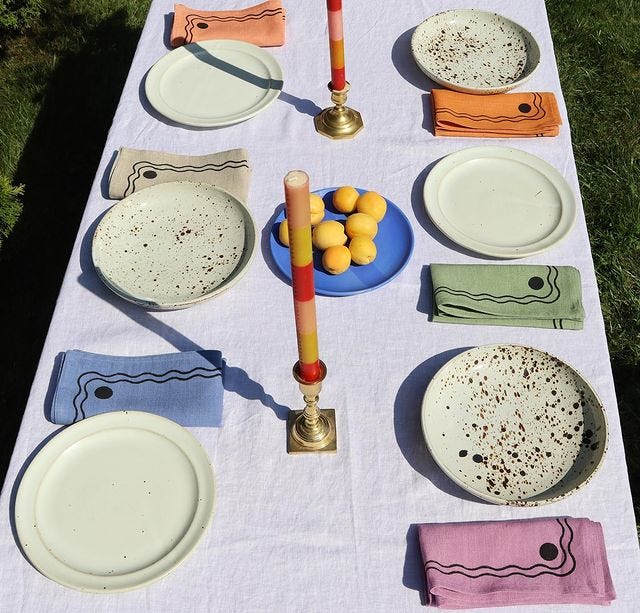Welcome back to A Piece of Cake! (That’s directed at you, and at me.) Yes, it’s been a minute, and thanks for sticking around. I hadn’t fully grasped how the stress of working this summer season had gotten to me. But, as it turns out, it kicked my ass. Not only was my brain bereft of cake recipes, but I even lost my hair. Like, literally stress-induced alopecia. Yes, folks, I have entered my bald era. Shaved head glamor shots to come.
But really, I got stressed and depressed and I desperately needed a break. I apologize for leaving subscribers hanging, but I’m happy to report I’m doing better. Now for some good news: I have a pretty decently shaped skull, steroids are being applied to my scalp daily, and the kitchen content machine has been cranked back into action.
Now that we’ve covered that, we can get to the good stuff: shoulder season eating. The produce is still rocking, but there’s a chill in the air. This summer, my dear friend and co-chef Dori Santos served a take on her family’s pork adobo at the restaurant, and I knew I wanted to share it with you all. It was perfect all summer, but I’m also looking forward to making it for these first chilly nights of fall. We sat down and talked about it right before we wrapped up our summer residency together. [The following is a slightly shortened version of our chat. We love to talk!]
B: Hi Dori. I’m so excited to share this recipe with my readers. Almost as excited as I was to eat this for the first time. Is this adobo something that you have made a lot as an adult?
D: I learned how to make it from my family, and then the more time I spent away from my family, it became something that I treated myself to as a way to kind of reconnect with that memory. I’d make it when I needed to feel like I was closer to them, even when I hadn't seen them in quite some time. Otherwise, this adobo was just something I could look forward to anytime I'd see my family. When I'd go home and visit, it would definitely get made at some point, by someone.
B: So it's definitely a comfort for you.
D: Yes, absolutely.
B: Was there ever a written recipe or was it always sort of like…
D: I feel like my great grandmother Dora [my namesake] had a recipe of sorts. Like, to tell you her way of doing it. But I don't think anybody in my family measures it out and I typically don't either. So, writing the recipe for the restaurant was not a challenge, but kind of a new thing.
B: I remember you saying that your father was one of five children, and your grandmother started adding corn to the adobo as a kind of way to fill it out?
D: I had always kind of wondered and suspected it was because my grandmother wanted to stretch the meal. And that is kind of, sort of why she did it. But also, everyone in our family makes this a little bit differently. So this version is inspired by my grandmother, who was inspired by my great-grandmother's, who also made adobo with corn. I called my aunt today to ask her some questions about this recipe, and she reminded me that everyone in the family makes adobo their own way. Adobo doesn’t have that many ingredients. So every person in every family kind of puts their own little spin on it—because they like a little more vinegar, a little more garlic, or somebody likes ginger. And somebody else doesn't. Like, my one aunt is obsessed with garlic. So her adobo is super garlic-heavy.
B: This version is not not garlic heavy. In the best way!
D: True. I mean, I'm also obsessed with garlic. But back to the corn: I asked my aunt about that and she said it kind of comes from the generational shift from being from the Philippines to being Filipino American and having a bigger family. And you serve the adobo with rice—so that's meat, starch, and then you have a vegetable. And I mean, corn is not like a green vegetable—
B: —But it's still a vegetable. Sort of like doing this very mid-century American idea of the meat, potato, vegetable combo.
D: Yep. And at first, I was thinking I wasn't going to serve it at the Beer Garden with the corn, but I realized it was so important to me, because of how it’s tied up in my memory of the dish. Like, when I was a kid and didn't really eat meat, I would still eat the rice with the corn and the jus from the adobo. And then I started eating meat, so I would just eat all of it. But the corn was always part of it.
B: Obviously your adobo is evocative of your grandmother's recipe and a real nod to it. But what have you sort of tweaked or changed to make it yours or like different?
D: The addition of ginger is my own. I love ginger. My dad was always not a fan of it, so it wouldn't ever really show up in any of my mom's cooking. He's kind of come around to it. But the ginger is mine. And also I added ketchup to give the jus a little more body.
And I'd read a lot about how different families make adobo: some families will put Sprite to add an element of sweetness, to balance out the sourness of the vinegar. And I also read about ketchup, and I just thought that's a perfect way to give body. Because it's the same way that you would use tomato paste in a more Eurocentric dish. I mean, ketchup already has everything in it. It has vinegar, it has a little sugar, and it's got a perfectly balanced flavor. So why not?
B: And Heinz is the ketchup.
D: Absolutely. You know, my identity is a fourth-generation Filipino American, and I’m leaning into that with this, and also making it mine. I like how this dish has evolved to be what I’ve made, and what I've served at the restaurant, and that people have really enjoyed it. I feel really great and thankful.
B: It was very clearly one of the most popular dishes on the menu. I’m not surprised. Were you surprised?
D: On the one hand, yes, I was. We were serving hot pork by the sea, in the summer on Cape Cod. But also, for what a significant dish it is in my life, and how good it makes me feel? It's not at all surprising to me that it could be the same for people who are trying it, maybe for the first time.
B: And over the summer there were multiple other Filipino Americans who have come in and eaten it and commented on it or sent a server back to thank you.
D: I know, I've loved that. And those have been some of my favorite moments and that makes me feel really good. But a part of me was also nervous about how particularly other Filipinos or Filipino Americans would judge it against their own families' versions of it. But it's been really cool to know that I'm providing that experience in a town where you wouldn't otherwise have dishes like this. I think a lot of people were surprised to find it.
B: Also, adobo can be made with any number of proteins. You can have chicken or fish.
D: Yeah. My grandmother bought chicken wings and did the pork and chicken wings together and that was great. And the chicken wings are kind of genius because they're the right size and they fall apart when you stew them and have just the right amount of fat and collagen to make the jus nice.
B: Totally. It's so funny. My grandmother MeMe used to do chicken legs and pork spareribs together braised in a vinegary barbecue sauce. And that was a staple of my childhood.
D: Yeah. That's not unlike what we were eating at all.
B: So at the restaurant, we use tamari instead of traditional soy sauce, so that it’s a gluten-free dish. And that's such a simple switch out. Any other tricks that you have? I know you like to let it marinate overnight?
D: Yeah, that's something that doesn't always happen. And I feel like at home, nobody wants to wait, but letting it marinate for at least a few hours definitely changes the flavor profile. It all kind of melds together. I mean, it's definitely optional, but I prefer it.
B: Cool. Well, I think that's a pretty great newsletter right there. Thanks so much for doing this!
Dori Santos’ Pork Adobo (adapted by Bill Clark)
6 pounds boneless pork shoulder, cut into 2-inch chunks
1 head of garlic, peeled and chopped
1 decent knob of ginger, peeled and sliced ⅛ in slices
1 teaspoon red pepper flake
3 tablespoons Diamond Crystal kosher salt
1 tablespoon ground black pepper
2 tablespoons granulated sugar
6 bay leaves, fresh preferred
2 tablespoons whole black peppercorns
1 ½ cups apple cider vinegar
1 ½ cups soy sauce
2 tablespoons ketchup
1 cup water
2 ears of corn, kernels cut from the cob
Combine all ingredients, except for the corn. Marinate for at least 2 hours, overnight if possible.
Place marinated mixture into a Dutch oven. Cover tightly with aluminum foil, and then the lid. Braise at 375 degrees for 3 hours, or until the pork is fork-tender.
Remove the pork from the braising liquid. Strain the braising liquid and bring it to a boil on the stovetop. Reduce the liquid by half.
Add the corn kernels to the reduced liquid and simmer for a few minutes until the corn is tender.
Serve the pork over rice with the braising liquid and corn spooned over.
Quick Bites:
My friend @steakdiane launched Chez Diane this week, a line of goods for the home and body that I’m salivating over.
Speaking of good stuff for the home, I’m also freaking over the linens over at Sunday Monday. Don’t be shocked if you see these napkins pop up in a future newsletter.
A little spooky season tip to my fellow Halloweenies out there: it’s time to book your tickets for what is, in my opinion, the best haunted hayride/house situation in the tristate area. Headless Horseman Haunted Attractions in Ulster Park is a Walking Trail, Corn Maze, and like 10 Haunted Houses?! You know that tweet that’s like, “If I pay $40 for a haunted house I better die”? This is one haunted house that’s actually worth the money.
A Piece of Cake is written by Bill Clark and edited by Andrew Spena. Photography by Hunter Abrams. Logo design by Brett LaBauve.









Glad you have returned. You took care of yourself; you never need apologize for nurturing yourself.